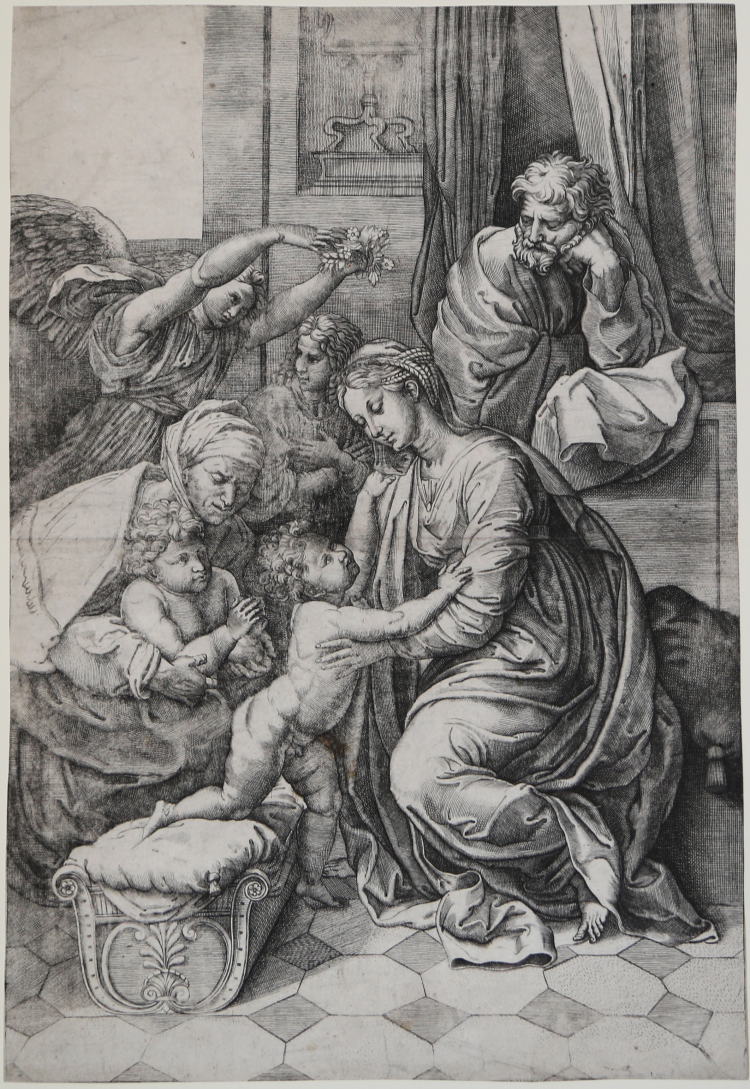



| Reference: | S30168 |
| Author | Gian Jacopo CARAGLIO |
| Year: | 1520 ca. |
| Measures: | 425 x 287 mm |


| Reference: | S30168 |
| Author | Gian Jacopo CARAGLIO |
| Year: | 1520 ca. |
| Measures: | 425 x 287 mm |
Engraving, 1520 circa, not dated or signed.
Example in the first state of two, before the letters 'R V'.
Magnificient proof, printed on contemporary laid paper, trimmed close to platemark, central fold visible on the back, otherwise very good condition.
The compositione derives, in reverse, from the Raphael painting (today in the Louvre, inv. no. 604). In 1518, he received the commission to paint The Holy Family from Pope Leo X and his nephew, Lorenzo II de Medici, duke of Urbino, to be offered as a gift to Claude, the Queen Consort of France, wife of Francis I. Painted in just two months, April and May, it was delivered at the end of May and, although signed and dated by Raphael, his assistants, particularly Giulio Romano, mentioned by Vasari, are considered to have done a lot of work on it. Raphael, despite his exceptional ca¬pacity for work, had a heavily manned workshop to deal with his rapidly increasing commitments. Together with this painting for the Queen of France, the Medici also commissioned a Saint Michael, Archangel (The Louvre) destined to be offered as a gift to Francis I.
Four of these drawings survive, one held in the Louvre, Young Woman with Her Arms out to a Child, and two in the Uffizi, Child and Study for a Virgin with the Child. Raphael’s authorship of these three drawings is by no means wholly accepted, as some researchers believe them to be the work of of Giulio Romano. And, finally, the collection of the Bonnat Museum in Bayonne (France) includes the Head of Saint Joseph, a beautiful fragment of the preparatory card for the figure of the saint.
According to Massari, the second state bears the letters 'R V' referring to the inventor.
Bibliografia
Passavant 1860, vol. II, p. 258; Le Blanc I.587.5; Gori Gandellini 1808-1816, VIII.44.3; Raphael Invenit, no. XXXII.1; Bianchi, La Fortuna di Raffaello, p. 674, e 687, nota 246; Bilbao Fine Arts Museum, no. 2, 2007, pp. 17-64.
Gian Jacopo CARAGLIO (Verona 1505 - Cracovia 1565)
|
Giovanni Jacopo Caraglio or Caralio, Caral, Caralius, was a copper engraver, gem cutter, goldsmith and maybe even architect, according to Vasari. Caraglio was born approximately in 1505, in Verona or Parma, that is the reason why he often refers to himself as Veronensis or Parmensis. Because of the Sack of Rome he was obliged to leave unfinished his Ratto delle Sabine (The Rape of the Sabine Women), after a drawing of Rosso Fiorentino. He moved to Venice, were he worked until 1537.
While in Rome, he worked for Baviera, realizing in 1562 Dei dell’Olimpo, Fatiche di Ercole and Amori degli Dei, all after Rosso’s drawings, his favourite artist, together with Baldinelli and Parmigianino. While in Venice, on the contrary, he worked on subjects from Titian.
He moved to Poland in 1539 and started spreading the graphic art of Marcantonio in the Eastern Countries.
On July the 3rd, 1545, he joined the Court of Siegmund II, with an annual salary of 60 florins, till the death of the King in 1548; he afterwards worked for King Siegmund II Augustus as goldsmith and gem cutter. In 1552 he’s said to be working in Vilna, in Lithuania, the second capital city of the kingdom where the Court had temporarily moved. He went back and forth from Italy to Lithuania untill he died, on August the 26th, 1565.
Bartsch has listed 65 engravings belonging to Caraglio; Le Blanc has added other four subjects.
|
Gian Jacopo CARAGLIO (Verona 1505 - Cracovia 1565)
|
Giovanni Jacopo Caraglio or Caralio, Caral, Caralius, was a copper engraver, gem cutter, goldsmith and maybe even architect, according to Vasari. Caraglio was born approximately in 1505, in Verona or Parma, that is the reason why he often refers to himself as Veronensis or Parmensis. Because of the Sack of Rome he was obliged to leave unfinished his Ratto delle Sabine (The Rape of the Sabine Women), after a drawing of Rosso Fiorentino. He moved to Venice, were he worked until 1537.
While in Rome, he worked for Baviera, realizing in 1562 Dei dell’Olimpo, Fatiche di Ercole and Amori degli Dei, all after Rosso’s drawings, his favourite artist, together with Baldinelli and Parmigianino. While in Venice, on the contrary, he worked on subjects from Titian.
He moved to Poland in 1539 and started spreading the graphic art of Marcantonio in the Eastern Countries.
On July the 3rd, 1545, he joined the Court of Siegmund II, with an annual salary of 60 florins, till the death of the King in 1548; he afterwards worked for King Siegmund II Augustus as goldsmith and gem cutter. In 1552 he’s said to be working in Vilna, in Lithuania, the second capital city of the kingdom where the Court had temporarily moved. He went back and forth from Italy to Lithuania untill he died, on August the 26th, 1565.
Bartsch has listed 65 engravings belonging to Caraglio; Le Blanc has added other four subjects.
|